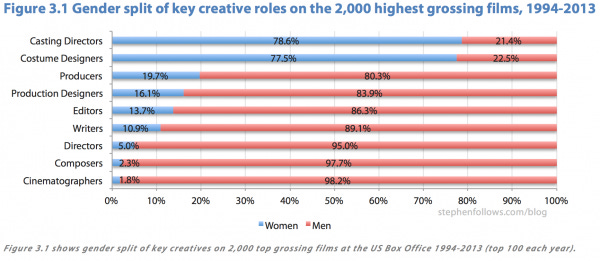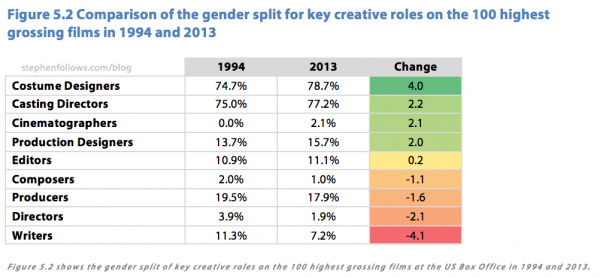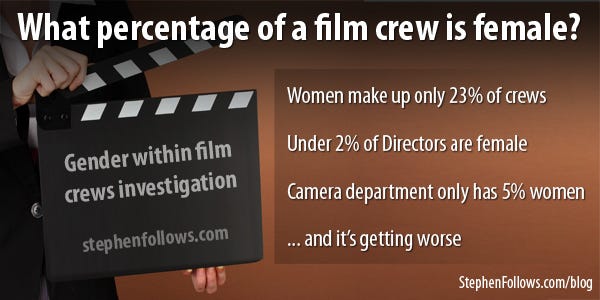What percentage of a film crew is female?
Today I am releasing the results of a long-term project. For a while, I've been looking at the numbers behind female film crew members over the past 20 years.
The results are pretty shocking, and should hopefully serve as a wake up call to parts of the industry. I don't believe that the majority of the industry is fundamentally sexist or anti-women but when you look at these results, especially over time, it's plain to see that something is wrong and it isn't fixing itself.
Download the full report now, for free. This project was far too large to fit into a single blog post, so I've written it up as a PDF report. It spans 16 pages and breaks down the results in much more detail. The report is free and all you need to do to get it is sign up to my e-mail list.
I send out one e-mail every week or two, to highlight new articles on this blog around film data and statistics. You can unsubscribe anytime, I won't sell or pass on your email address, there's no spam... it's just me.
The results in summary
I studied the 100 highest grossing films at the US Box Office for each year between 1994 and 2013 (a total of 2,000 films). Additionally, in order to see how a film’s genre affects gender employment, I also looked at the 100 highest grossing films for each genre.
In summary...
Women make up only 23% of crew members on the 2,000 highest grossing films of the past 20 years.
Only one of the top 100 films in 2013 has a female Composer.
In 2013, under 2% of Directors were female.
The only departments to have a majority of women are Make-up, Casting and Costume
Visual Effects is the largest department on most major movies and yet only has 17.5% women
Of all the departments, the Camera and Electrical department is the most male, with only 5% women
Musicals and Music-based films have the highest proportion of women in their crews (27%).
Sci-Fi and Action films have the smallest proportion of women (20% and 21% respectively).
The films with the highest percentage were "Mean Girls" and "The Sisterhood of the Travelling Pants" (42%).
The most male crews were "On Deadly Ground" and "Robots" (10% female).
There has been no improvement in the last 20 years. The percentage of female crew members has decreased between 1994 (22.7%) and 2013 (21.8%).
The three most significant creative roles (Writer, Producer and Director) have all seen the percentage of women fall.
The jobs performed by women have become more polarised. In jobs which are traditionally seen as more female (art, costume and make-up) the percentage of women has increased, whereas in the more technical fields (editing and visual effects) the percentage of women has fallen.
On average, women make up 22.6% of a film crew
On average, over the last 20 years, women have made up 22.6% of film crew members. The average for 2013 was actually lower, at 21.8%.

By department
Of all the departments, the Camera and Electrical department is the most male, with only 5% women. The only departments to have a majority of women are Make-up, Casting and Costume. Visual Effects is the largest department on most major movies and yet only has 17.5% women.

There is a clear pattern to which departments employ women. The data doesn't give me any way of telling if this is through free choice of the female crew members or a consequence of sexist hiring practices.
Key creative roles
Whilst gender equality is important in all roles, it is especially relevant when looking at the key creative roles. The positions of Writer, Producer and Director have the largest influence on the end product and therefore the representation of women on-screen. They are also more likely to serve as visible female role models for aspiring filmmakers.
Over the last 20 years, the percentage of women in key creative roles has been poor: Directors (5%), Writers (11%) and Producers (20%). The majority of key creative roles are overwhelmingly male, with the clear exception of Casting Directors and Costume Directors. Composers are only 2% female and only one of the top 100 films of 2013 had a female Composer.

Which genres hire the most women?
In addition to my main study, I also researched the top 100 grossing films of each genre. Interestingly, the genres with the highest proportion of women in the crew are extremely similar to the genres that are enjoyed most by female film audiences.
Musicals and Music-based films have the highest proportion of women in their crews (both with 27% women) and Sci-Fi and Action films have the smallest proportion (20% and 21% respectively).

In the last 20 years it's got worse
When I started to see the results come together I was rather shocked by the averages. I had guessed that women would be under-represented but not much such a large margin. But the most shocking revelation was still to come. I had assumed that due to progress being made in our wider society that the gender imbalance would soon resolve itself.
It has not. In fact, in 1994 the average percentage of women on a film crew was 22.7% and by 2013 it had actually shrunk slightly to 21.8%.

Jobs for the girls
Not only is the average falling, but the jobs that women are getting are becoming increasingly polarized. The percentage of women has grown in Make-up, Art and Costume departments and decreased in the fields of editing and animation.

The three most significant creative roles (Writer, Producer and Director) have all seen the percentage of women fall over the past 20 years.

The data doesn't tell us why this is happening but an obvious candidate would be the shift in the post-production fields to become more reliant on technology (traditionally a more male area). That said, even if that were true, it would only explain, not defend, this shift. Another possible reason could be increasingly sexist views in which jobs are seen as 'male' and which are seen as 'female'.
To see a breakdown of these stats in much more detail, return to the top of the page and sign up for the full report.
The 'most male' and 'most female' film crews
Using my dataset of the top 2,000 grossing films of the past twenty years, I have created lists of the films that have had the highest proportion of women in the crew. I named this system The Fey-Seagal Scale after Tina Fey and Steven Seagal, who represent the two ends of the spectrum.
Tina Fey wrote “Mean Girls”, which is the ‘most female’ film on my list and she is seen by many as a strong female role model in the entertainment industry. Steven Seagal stars in three of the twenty ‘most male’ films, as well as directing the ‘most male’ film “On Deadly Ground”, and in the past has been accused of sexual harassment on a number of occasions. The fitting nature of these two faces at either end of the scale amused me and so felt like an appropriate name.


Does any of this matter?
There are many reasons why the under-representation of women in the film industry could be seen as a problem. These include female crew members finding it harder to get hired/paid, employers selecting workers from a pool that is half the size it should be, fewer female role models for aspiring creatives and, of course, justice/ equality/ fairness.
Another possible problem is a weaker female perspective in stories and characters. Last year on this blog I investigated the question “Do female audiences prefer to watch films made by female filmmakers?”
I shan't spoil the outcome in this article but you can see the results at stephenfollows.com/do-women-prefer-films-made-by-female-filmmakers.
Voices from the industry on female film crew numbers
Before publishing, I sent these results out to a few industry professionals to gauge their reaction. Universally, all respondents had the same shocked response I did. Here are just a few...
Stephen’s research has uncovered and highlighted a shocking situation. In spite of efforts to achieve greater gender balance within the industry, especially in these busier times, the reality seems to be that it’s getting worse, not better. These statistics must propel industry and inform government policy to increase the pursuit of proper diversity in the workforce- Iain Smith, Producer ("24", "Wanted" ,"The Fifth Element")
We need and deserve a film culture that reflects the diversity of audiences that exist and that won’t be forthcoming until the people who make films and contribute to their delivery reflect that diversity. Like a lot of complicated issues I think that what we need is a series of quite complicated solutions that address the problem from the top to the bottom, a series of coordinated and thoughtful interventions that enable change to occur. Until then we won’t have the role models or range of stories told that we need.- Catharine Des Forges, Director, Independent Cinema Office
This document is amazing. The figures make for a wake-up call to the industry and to film schools throughout the world. We have to ask ourselves- what can we do to change this picture?- Paul Thompson, Associate Professor, Dept of Film and Television,NYU. Former Head of Film and Television, AFTRS, Sydney, Australia
We have seen that this situation is similar throughout Europe and reflects the urgent need for associations such as ours to devise combined measures to counter inequality: be it through targeted training, promoting the work of women in the industry, carrying out more comprehensive research to show just how imbalanced the situation is and drafting policy proposals at national and pan-European levels.- Francine H. Raveney, Executive Director of the European Women's Audiovisual Network
Firstly, yes, these statistics are damning. Representing an organisation that is educating and training a new generation of professionals working across the creative industries, I’m proud of the fact that 46% of our students on BA and MA programmes enrolling this year are female, and hopefully that’s some indication of this situation improving in the future. I hope also that the revolution happening in production processes, enabled by digital technologies, which I think is only just beginning to tell, will be a catalyst in this change – as access, use, and exploitation is increasingly democratised.- Jonny Persey, Chief Executive, Met Film School
These are disheartening statistics, but I don’t think the way talent was found in the past is the way it will be found going forward. I do think women are reserved about putting their voice out there and demonstrating their talents in a public way. This has to change and part of the mindset change for all working in the industry is to stop waiting to be picked, stop hiding only behind your for hire work, stop being invisible. Step forward, pick up the ‘mic’ that is the internet and show us who you are, what you know, what you can do and how it helps the industry. Believe me, people who can change your life are watching this space. Pick yourself and others will follow.- Sheri Candler, Marketing and Publicity Guru
It’s integral that organisations in this industry are proactive about the issue of the number of women in film production – at Sheffield Docfest we are always aware of addressing gender equality in terms of our film programme, our speaker programme and also for the producers selected in pitching initiatives at the festival. This year at Sheffield Doc/Fest over 50% of the applications to our flagship market event the MeetMarket – where filmmakers pitch to commissioners and buyers – were female. From that, the percentage of female filmmakers selected to pitch projects in our market was also around 50%. We are very proud of our commitment to helping female documentary makers in the industry. In documentary, there are more female producers than there are directors and it would be good to see some action on getting more female directors in the industry. Hopefully the statistics collected recently will trigger some positive action in this area. We believe women should be treated as equal partners in the creative process of filmmaking – across directing, producing, editing, camera, sound and all other roles of production. It’s also about leading women in the industry standing up as great role models – there are many stand out talented women in the documentary industry and that includes commissioning editors as well as film makers – we are very keen to see an increased number of women in the documentary industry and plan to continue to make a positive contribution to that effort by being diligent about female representation in all our programmes.- Heather Croall, Festival Director, Sheffield Doc/Fest
Epilogue
My data sources, methodology and limitations of this research are detailed in the full report: for brevity's sake I have decided to leave them out of this article. If you're interested in seeing further results, or understanding how I carried out this research then please download the full PDF report as detailed at the top of this article.
I'm grateful to everyone who has supported my work and helped my in my journeys through film data. Not least Sophie Lifschutz without whom this blog would be far less readable and Alyssa Thorne who may be responsible for you reading it in the first place.



